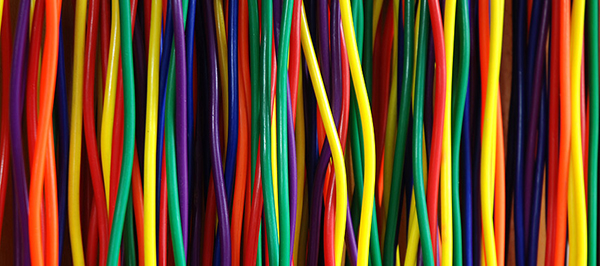It may seem like a wireless world, but rumors of the wire’s demise have been greatly overstated.
 WORDS: JASON GRIFFING
WORDS: JASON GRIFFING
From cell phone networks to ubiquitous WiFi to a plethora of Bluetooth devices, wireless technology is now part of our daily lives. So it’s no surprise that many people consider hardwired connections antiquated—the home-tech equivalent of a VCR or 8-track player. But the truth is that for many applications, especially home technology, the need for physical wires isn’t going away anytime soon.
Here are five reasons to avoid counting exclusively on wireless capabilities when planning for home technology:
1) Hardwired Connections are Inherently Faster and More Stable
Much like our beloved city’s roadways, as the number of devices utilizing our wireless airways has increased, so too has the congestion. The wireless equivalent of rush hour traffic is known as RF (radio-frequency) interference, and it’s on the rise. Our devices struggle to communicate over this noise, which can cause notable lag and sluggish networks. Akin to a new highway express lane, a hardwired network connection skirts this traffic, performing measurably faster, and with greater stability, than its wireless counterpart.
2) 4K Ultra-High Definition Video Has Arrived
4K, also known as Ultra-High Definition, represents the latest in video technology. At four times the resolution of previous 1080 HD technology, it delivers stunning picture clarity—but that clarity comes at a cost. Put simply: four times the pixels equates to four times the amount of data. Transporting this amount of information from point A to point B requires a hardwired connection. For one example, look to DirecTV’s new (and highly-touted) “Wireless Genie” system, which limits support to 1080 HD, and will not do 4K.
3) Wireless Audio Isn’t Always Wireless
The term “wireless” can be misleading, implying the complete absence of any physical connections. For many devices this is overstating the case. Consider, for instance, wireless audio. Some of the most popular systems marketed as wireless still require connection to an electrical outlet. Moreover, if these audio systems are to be used in conjunction with external speakers (think bookshelf or in-ceiling), then old-fashioned speaker wire is still required.
4) Even True Wireless Needs Wires
In spite of some drawbacks, wireless technologies are an integral part of today’s home. Getting the most from these technologies requires a little planning. The most obvious example is the need for proper WiFi coverage. Pulling network cable to evenly dispersed locations throughout the home enables the use of dedicated WiFi access points. This eliminates dead spots, allowing uninterrupted use of your wireless devices.
5) Wire is Cheap, Retrofit Isn’t
Many people assume that a comprehensive technology pre-wire must be complicated and expensive, but that’s not necessarily the case. On the other hand, opening up walls to fix oversights is almost always costly and time consuming. If for no other reason, a basic technology pre-wire should be considered as an inexpensive insurance policy, ensuring tech-compatibility for the life of the home.
We see wireless technologies getting more and more sophisticated before our very eyes, enabling a wide array of options in home technology that simply didn’t exist before. It’s an exciting development, but wireless is not a cure-all—especially for those of us who pay close attention to the way our homes are designed. As much as we love to hate them, wires still have a place in our connected homes … but it’s probably safe to go ahead and get rid of that 8-track player.




